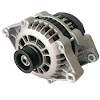Equalizer Bar or Ring:
Show two identical series generators connected in parallel. Suppose E1 and E2 are initially equal, generators supply equal currents and have equal shunt resistances. Suppose E1 increases slightly so that E1 > E2. In that case, I1 becomes greater than I2. Consequently, field of machine 1 is strengthened thus increases E1 further whist the field of machine 2 is weakened thus decreasing E2 further. A final stage is reached when machine 1 supplies not only the whole load but also supplies power to machines 2 which starts running as a motor. Obviously, the two similar machines pass approximately equal currents to the load, the slight difference between the two currents being confined to the loop made by the armatures and the equalizer bar.
 |
Compound Generators in Parallel
Two compound generators running in parallel. Because of the rising characteristics of the usual over compounded generators, it is obvious that in the absence of any corrective devices, the parallel operation of such generators in unstable. Let us suppose that, to begin with, each generator is taking its proper share of load. Let us now assume that for some reason, generator No. 1 takes a slightly increased load. In that case, the current passing through its series winding increases which further strengthens its field and so rasises its generated e.m.f. thus causing it to take still more load. Since the system load is assumed to be constant, generator No. 2 will drop some of its load, thereby weakening its series field which will result in its further dropping off its load. Since this effect is cumulative, generator No. 1 will, therefore, tend to take the entire load and finally drive generator No. 2 as a motor. The circuit breaker of at least one the two generators will open, thus stopping their parallel operation.
For making the parallel operation of over-compound and level-compound generators stable, they are always used with an equalizer bar connected to the armature ends of the series coils of the generator stable, they are always used with an equalizer is a conductor of low resistance and its operation is as follows:
Suppose that generator No. 1 starts takes more that its proper share of load. Its series field current is increased. But now this increased current passes partly through the series field coil of generator No. 1 and partly it flows via the equalizer bar through the series field winding of generator No. 2. Hence, the generators are affected in a similar manner with the result that generator No. 1 cannot take the entire load. For maintaining proper division of load for no-load, it is essential that
i) The regulation of each generator is the same
ii) The series field resistances are inversely proportional to the generator rating.









0 Comments